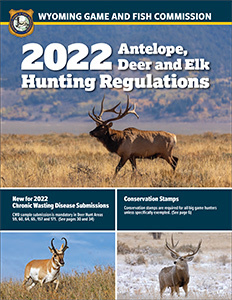Be Bear Aware
Game retrieval and handling
- Immediately remove carcasses from the field. The longer game is in the field, at camp, or in a vehicle, the more likely it is to be discovered.
- Separate the carcass from the gut pile with as much distance as possible if you must leave meat in the field for any time.
- Ideally leave the gut pile in the field far away from camps, roads, trails.
- If an animal is harvested by a camp, road or trail, move the gut pile or parts 1⁄2 mile away or to a landfill.
- Quarter and hang the carcass in a tree or game pole 10 to 15 feet from the ground and 4 feet from the tree trunk or supporting branches.
- If you must leave the carcass on the ground, place it in plain view so you can see if a bear is present or if it has been disturbed when you return. Placing large items such as branches or a jacket on the carcass so you can tell from a safe distance if a bear has disturbed your carcass.
- When returning to a carcass stop and view the area from a distance with binoculars. Approach the carcass from upwind and make sufficient noise to alert any bears of your presence. Just because you don’t see a bear doesn’t mean there isn’t one in the area.
- When retrieving meat go with your hunting partners and if possible approach on horseback.
- If you detect disturbance from a distance or if the carcass has been buried, a bear has probably been to the carcass or may be bedded nearby.
- Never attempt to scare a bear off of a carcass it has claimed.
- Have a plan on how to recover an animal before you harvest one and use extra caution if harvesting an animal late in the day.
What to do if you see an aggressive /defensive bear at close range
- Try to remain calm, slowly back out of the area, and have a defense ready.
- Never run away from the bear.
- Do not challenge the bear with aggressive body language, direct eye contact or shouting.
- If the bear begins to approach, stand your ground and use bear spray if available.
- If a bear makes contact or is about to make contact, drop and cover by lying flat on your stomach inter-lacing your fingers and placing them on the back of your neck. Do not fight back.
- Once the bear feels the threat is neutralized it will usually stop attacking.
- Make certain the bear has left the area before you retreat or move.
How and when to use bear spray
- Bear spray is an effective deterrent that is designed to deter aggressive bear behavior.
- Studies have shown that bear spray is more effective than firearms at reducing your chances of injury.
- Make sure that you are carrying an EPA registered Bear Spray and not another form of self protection pepper spray.
- Bear spray is to be used on a charging bear or in an aggressive encounter.
- It sprays 25-30 feet as it creates a 4-foot cloud.
- Each member of a party should carry spray.
- Bear spray must be carried where it is readily accessible.
If a bear comes into your camp
- Remain calm and do not panic. Bears generally avoid people and they are probably attracted to odors of food.
- Ready your bear spray or firearm for use.
- Do not approach the bear.
- Try to scare the bear away by yelling, shouting, or making other loud noises.
- If the bear does not get a food reward they will usually leave.
- If a bear tries getting into your tent fight back and use your personal defense.
For more information about staying safe in bear country, visit the WGFD bear wise page.

